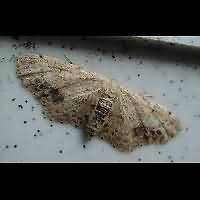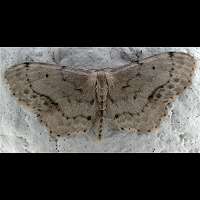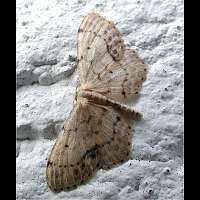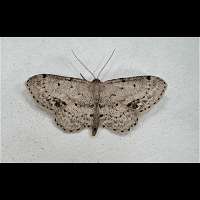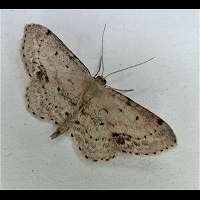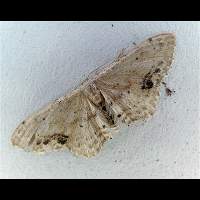Single-dotted Wave (Idaea dimidiata)
The Single-dotted Wave is one of the easiest waves to identify, even in the field. The ground colour is whitish and the outer area towards the trailing corner of the forewing is darkened. In well marked specimens this is a clear blackish band. But even in slightly marked animals the darkening is clearly visible. The wingspan is some 17 to 22 mm.
The eggs hatch in august and out comes a caterpillar that'll grow to some 20 mm. It is pale brown. On top a double black line, merging into a single broad line towards the tail. On the sides a white line. The head is grey. The larvae overwinter in plant debris. The caterpillars pupate in a cocoon in the soil in June, often producing the adult moths within 4 weeks. Regularly found on cow-parsley, burnet-saxifraga and hedge bedstraw and on some other plants.
There is just one generation per year, flying about in July, although smaller numbers of specimens are seen in June and August. The moths fly as soon as dusk sets in and are sometimes early enough to be visible visiting flowers, preferring thistles apparently. This is a common species in woodlands, hedgerows and gardens. It is attracted to light, but in small numbers only. Common in England, Wales and Ireland, rare in Southern Scotland and absent in the north. On the continent common all over, except for Northern Scandinavia. However this species is never seen abundantly anywhere.
The Single-dotted Wave is one of the easiest waves to identify, even in the field. The ground colour is whitish and the outer area towards the trailing corner of the forewing is darkened. In well marked specimens this is a clear blackish band. But even in slightly marked animals the darkening is clearly visible. The wingspan is some 17 to 22 mm.
The eggs hatch in august and out comes a caterpillar that'll grow to some 20 mm. It is pale brown. On top a double black line, merging into a single broad line towards the tail. On the sides a white line. The head is grey. The larvae overwinter in plant debris. The caterpillars pupate in a cocoon in the soil in June, often producing the adult moths within 4 weeks. Regularly found on cow-parsley, burnet-saxifraga and hedge bedstraw and on some other plants.
There is just one generation per year, flying about in July, although smaller numbers of specimens are seen in June and August. The moths fly as soon as dusk sets in and are sometimes early enough to be visible visiting flowers, preferring thistles apparently. This is a common species in woodlands, hedgerows and gardens. It is attracted to light, but in small numbers only. Common in England, Wales and Ireland, rare in Southern Scotland and absent in the north. On the continent common all over, except for Northern Scandinavia. However this species is never seen abundantly anywhere.

